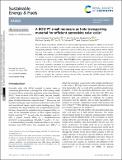Files in this item
A BODIPY small molecule as hole transporting material for efficient perovskite solar cells
Item metadata
| dc.contributor.author | Dos Santos, John Marques | |
| dc.contributor.author | Jagadamma, Lethy Krishnan | |
| dc.contributor.author | Cariello, Michele | |
| dc.contributor.author | Samuel, Ifor D. W. | |
| dc.contributor.author | Cooke, Graeme | |
| dc.date.accessioned | 2022-09-08T09:30:14Z | |
| dc.date.available | 2022-09-08T09:30:14Z | |
| dc.date.issued | 2022-08-30 | |
| dc.identifier | 281224882 | |
| dc.identifier | fea8b478-ec67-48f8-8d51-f9129c68b1e6 | |
| dc.identifier | 000847468400001 | |
| dc.identifier | 85138028461 | |
| dc.identifier.citation | Dos Santos , J M , Jagadamma , L K , Cariello , M , Samuel , I D W & Cooke , G 2022 , ' A BODIPY small molecule as hole transporting material for efficient perovskite solar cells ' , Sustainable Energy & Fuels , vol. Advance Article . https://doi.org/10.1039/d2se00667g | en |
| dc.identifier.issn | 2398-4902 | |
| dc.identifier.other | Jisc: 588748 | |
| dc.identifier.other | ORCID: /0000-0002-4339-2484/work/118799920 | |
| dc.identifier.uri | https://hdl.handle.net/10023/25974 | |
| dc.description | JMS acknowledges the Coordenação de Aperfeiçoamento de Pessoal de Nível Superior – Brasil (CAPES) – Finance Code 001 for PhD funding. LKJ acknowledges support from the Marie Skłodowska-Curie Individual Fellowship (European Commission) (MCIF: no. 745776) and funding from UKRI-FLF through MR/T022094/1. GC thanks the EPSRC (EP/E036244/1) for funding. | en |
| dc.description.abstract | BODIPY-based materials are well known for their outstanding chemical and photo-stability as well as their ease of synthesis and tunability of their frontier molecular orbitals. These are attractive features for hole transporting materials (HTMs) for perovskite solar cells (PSCs) that could help improve device stability and cost. In this paper, we report the straightforward synthesis of a new BODIPY small molecule, PTZ-PTZ-BDP , functionalised with phenothiazine moieties in both the meso and α positions giving rise to a Y-shaped structure. As estimated by DFT calculations, and confirmed by electrochemical and ambient photoemission spectroscopy studies, PTZ-PTZ-BDP presents appropriate energy levels suitable for its use as a HTM in PSCs. Electrochemical measurements also reveal several redox processes with excellent reversibility. Systematic evaluation of its performance as HTM in n–i–p PSC with and without dopants was conducted and the device parameters compared with commonly used HTMs of spiro-OMeTAD and PTAA. The CH3NH3PbI3 based PSCs incorporating simple solution processed PTZ-PTZ-BDP as HTM demonstrated a champion power conversion efficiency of 14.6%, matched in performance and shelf-life stability to complex and expensive state-of-the-art HTMs, showing that BODIPY based HTMs are a promising direction for perovskite solar cells. | |
| dc.format.extent | 9 | |
| dc.format.extent | 1191954 | |
| dc.language.iso | eng | |
| dc.relation.ispartof | Sustainable Energy & Fuels | en |
| dc.subject | QD Chemistry | en |
| dc.subject | NDAS | en |
| dc.subject.lcc | QD | en |
| dc.title | A BODIPY small molecule as hole transporting material for efficient perovskite solar cells | en |
| dc.type | Journal article | en |
| dc.contributor.sponsor | European Commission | en |
| dc.contributor.institution | University of St Andrews. School of Chemistry | en |
| dc.contributor.institution | University of St Andrews. School of Physics and Astronomy | en |
| dc.contributor.institution | University of St Andrews. Centre for Energy Ethics | en |
| dc.contributor.institution | University of St Andrews. Centre for Biophotonics | en |
| dc.contributor.institution | University of St Andrews. Condensed Matter Physics | en |
| dc.identifier.doi | 10.1039/d2se00667g | |
| dc.description.status | Peer reviewed | en |
| dc.identifier.grantnumber | 745776 | en |
This item appears in the following Collection(s)
Items in the St Andrews Research Repository are protected by copyright, with all rights reserved, unless otherwise indicated.

